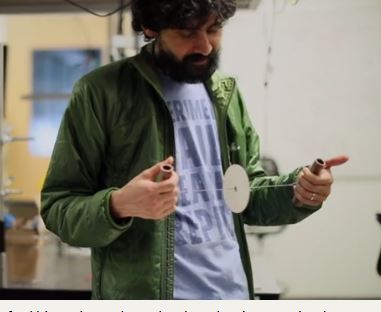Share This
Related Posts
Tags
Low-Tech Diagnostics
By Cutright Elizabeth on Feb 3, 2017 in Technology
For caregivers in economically depressed communities, even the simplest tests can be too expensive. But thanks to the Paperfuge, spinning biological samples for testing just got a whole lot more economical. The Paperfuge allows health care workers to perform important diagnostic tests in just a few minutes, all for less than a twenty-five cents.
Understanding the need to provide low-cost, and low-tech, testing and diagnosis options to the developing world, Stanford Bioengineer Manu Prakash alighted on the idea of modifying a children’s toy into a cheap, functional centrifuge. It’s all a part of Prakash’s commitment to improving healthcare across the globe by pursuing the art of Frugal Science.
“To me, Frugal Science is really designing with constraints in mind,” says Prakash in a video about the Paperfuge. “When we say ‘bringing tools the masses,’ we truly do mean the billions of people on the planet.”
Low Energy, High Results
Traditional centrifuges are bulky, expensive and require a robust energy supply, making them almost impossible to operate in far-flung reaches of the world. A StatSpin MP centrifuge, for example, can cost thousands of dollars and runs on electricity. For many economically challenged communities, standard medical equipment is too costly and resource intensive.
Prakash and his team took on the challenge of making a more accessible – and affordable – version of this valuable diagnostic tool.
“We told ourselves, we can design one, but it cannot require any electricity, and it needs to be light and portable – I need to be able to carry it in my pocket – and it needs to cost less than a dollar in parts.,” explains Prakash in the video.
“By boxing ourselves in with constraints, we were able to think outside the box.”
The Paperfuge fits all of those limitations. Health workers, whether out in the field or in the office, simply apply a blood sample, via a small glass capillary, to the Paperfuge and pull the strings to initiate spinning. After about a minute, the entire sample will be separate into distinct parts for testing.
A New Twist on an Old Toy
The whirligig’s design has been around for thousands of years. At its most basic, the toy is nothing more than a small disk pierced by a strings that, when pulled, cause the disk to spin. While the assemblage may be simple, the physics behind it are much more complex.
“Conventionally, a string has a geometrically limit to what it can coil. And beyond that limit, the number of twists going beyond that limit will pop the string into the third dimension,” Prakash explains in the video. “It will start coiling in a hierarchical structure, which is a ‘coil of coils.’”
Creating this “coil of coils” results in supercoiling. With supercoiling, the disk at the heart of the whirligig can reach speeds of up to 125,000 rpm. When applied to the Paperfuge, the whirligig mechanics allow the paper testing-disk to hit up to hit up to 30,000 g-force, more than enough to separate plasma from a blood sample or isolate the malaria parasite.
“I find it quite fascinating to see the simplicity of toys and exploit those mechanisms in tools that we make because the sometimes the simplest solution is far more powerful,” says Prakash.
Frugal Science Philosophy
For Prakash, the Paperfuge is on the next step in a journey towards developing power, but affordable medical equipment to struggling communities. In 2012, Prakash introduced the Foldscope, a paper microscope that folds up in the manner of Japanese origami. The Foldscope also costs less than a dollar and packs enough microscopic punch to view microorganisms. Prakash alighted on the idea of a cheap centrifuge alternative after witnessing a hospital in Uganda using a broken device to prop open a door.
“When I returned from Uganda, I knew this was the next thing we were going to build,” he told Wired in a recent interview.
With the Paperfuge, Prakash continues to build on his commitment to providing low-tech and low-cost health care diagnostics to the developing world.
“There are a billion people on this planet who live with no electricity, no infrastructure, no roads,” says Prakash. “They have the same kind of health care needs that you and I have.”
